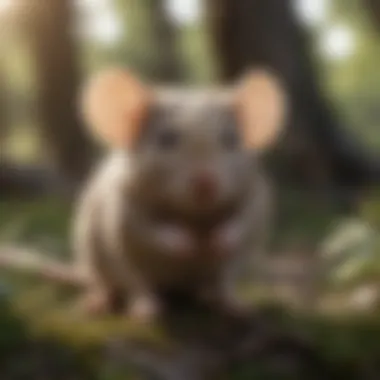Defending Your Home: Advanced Strategies for Keeping Mice Away


Animal Species Profile
In this segment focusing on rodent control strategies, it is crucial to understand the animal species at the center of the discussion: the common house mouse. These creatures, with their small bodies and distinctive pointy snouts, are ubiquitous in urban and rural environments alike. Their adaptability to various habitats, ranging from homes to fields, makes them challenging pests to manage efficiently. House mice exhibit complex social behaviors, often living in colonies within human structures, showcasing remarkable breeding capabilities and swift movements.
Pest Control Measures
When delving into effective strategies for rodent control, an array of approaches are at one's disposal. From traditional methods like traps and baits to modern technological solutions like ultrasonic repellents and electronic deterrents, the options are diverse. Integrating natural remedies such as peppermint oil or mothballs can also aid in deterring mice from infesting living spaces. It is essential to remember that maintaining cleanliness, sealing entry points, and regular inspections are fundamental practices in preventing and managing mouse infestations effectively.
Prevention Strategies
Prevention plays a key role in keeping mice away from homes and other areas. Simple yet crucial steps like storing food in airtight containers, eliminating clutter, and sealing cracks in walls and floors can significantly reduce the likelihood of rodent intrusions. Additionally, outdoor measures such as maintaining a tidy yard, keeping vegetation trimmed, and storing firewood away from buildings can create a less hospitable environment for mice. Consultation with pest control professionals can offer tailored advice and sustainable solutions for long-term mouse prevention.
Sustainable Solutions
In the realm of rodent control, sustainable practices are gaining momentum for their environmentally friendly and humane approaches. Employing integrated pest management (IPM) strategies that prioritize prevention, monitoring, and intervention can minimize reliance on chemical treatments while effectively managing rodent populations. These methods focus on addressing underlying causes of infestations, like food sources and access points, to create lasting solutions. By adopting sustainable practices, individuals and communities can promote a harmonious coexistence with wildlife while safeguarding human health and property.
Conclusion & Future Prospects
Understanding Mice Behavior
In this comprehensive guide on rodent control, an crucial aspect that must not be overlooked is comprehending the behavior of mice. Understanding how these pests operate is paramount for devising effective strategies to keep them at bay. By delving into the intricacies of mice behavior, one can identify patterns, preferences, and vulnerabilities that are pivotal in implementing successful rodent control measures. This section sheds light on specific elements of mice behavior that are instrumental in safeguarding homes from unwanted intrusions.
Rodent Habits and Preferences
Dietary Patterns
Delving into the dietary patterns of mice is crucial in devising effective rodent control strategies. Understanding what attracts mice in terms of food can aid in implementing measures to deter them. By comprehending their dietary habits, one can better protect their homes from infestations. Exploring the key characteristic of mice's dietary preferences and why certain food choices are more enticing for them is essential in developing a comprehensive approach. Additionally, analyzing the unique features of these dietary patterns can shed light on the advantages and disadvantages they pose in the context of rodent control.
Nesting Preferences


Mice have specific nesting preferences that play a significant role in their behavior. Understanding where and how mice prefer to nest provides crucial insights for effective rodent control. Highlighting the key characteristics of nesting preferences and why they influence mice behavior is essential for developing successful eradication strategies. By describing the unique features of mice's nesting habits, one can evaluate the advantages and disadvantages they present in the context of rodent control.
Typical Entry Points
When it comes to keeping mice away, understanding the typical entry points they exploit is pivotal. By identifying vulnerabilities in structures that mice use to gain access, homeowners can proactively reinforce these weak spots. Exploring the key characteristic of vulnerabilities in structures and why they are prime entry points for mice is imperative for effective rodent control. Additionally, examining common access areas that mice often utilize can provide insights into how to better safeguard homes from these unwanted visitors. Describing the unique features of these access points and the advantages and disadvantages they represent enriches the strategy for rodent control.
Natural Remedies for Mouse Repellent
In the realm of rodent control, natural remedies serve as a beacon of hope for many seeking to keep their homes free from unwanted furry intruders. Within this article focusing on effective strategies for rodent control, the section on natural remedies for mouse repellent stands out as a testament to the power of nature in combating pest infestations. By delving into the specifics of natural remedies, readers can uncover a treasure trove of insights ranging from environmentally friendly solutions to cost-effective methods. Understanding the significance of natural remedies provides a holistic approach to rodent control, aligning with the ethos of those who seek non-toxic alternatives for protecting their living spaces.
Peppermint Oil
Benefits and Application
Exploring the realm of natural remedies for mouse repellent, peppermint oil emerges as a star player in the quest for rodent control. Known for its potent scent that mice find repugnant, peppermint oil offers a dual benefit by serving as both a repellent and a refreshing aroma agent. The key characteristic that sets peppermint oil apart lies in its versatility, as it not only deters rodents but also leaves a pleasant fragrance lingering in the air. This dual function makes it a popular choice for those looking to safeguard their homes without compromising on sensory experiences. However, it's essential to note that while the benefits of peppermint oil are vast, its effectiveness may vary based on factors like application method and concentration levels. Therefore, weighing the advantages of using peppermint oil as a natural repellent warrants careful consideration to maximize its potential in rodent control strategies.
Steel Wool
Blocking Entry Points
When it comes to fortifying homes against rodent invasions, steel wool emerges as a stalwart defender in the battle against unwanted guests. The specific aspect of using steel wool for blocking entry points contributes significantly to the overall goal of rodent control by creating physical barriers that are tough for mice to penetrate. Highlighting its key characteristic of durability, steel wool serves as a sturdy defense mechanism that effectively seals off potential access routes for rodents. This makes it a beneficial choice for inclusion in this article, particularly for its reliability in preventing rodent entry. Despite its effectiveness, one must acknowledge the unique feature of steel wool, wherein it may require periodic checks and replacements due to wear and tear. Understanding the advantages and disadvantages of employing steel wool helps readers make informed decisions on integrating this formidable material into their rodent control arsenal.
Ammonia Soaked Cotton Balls
Placement and Effectiveness
Ammonia soaked cotton balls take center stage as a tactical tool in the realm of natural pest control, specifically targeting mice infestations. Their unique aspect of emitting a strong odor that repels rodents solidifies their contribution to the overall goal of effectively deterring mice from encroaching on domestic spaces. Highlighting the key characteristic of ammonia's potent scent, these cotton balls are strategically placed in areas prone to rodent activity to maximize their repellent effect. This placement method makes them a popular choice for rodent control measures discussed in this article, given their proven track record of effectiveness. While the advantages of ammonia soaked cotton balls in repelling mice are significant, it is essential to consider their potential drawbacks, such as the need for regular replacement to maintain their potency. Evaluating the placement and effectiveness of these natural remedies provides readers with valuable insights into leveraging their efficacy in safeguarding homes from unwanted rodent intrusions.
Maintaining Cleanliness and Organization
Ensuring cleanliness and organization within your living space plays a pivotal role in deterring mice infestations. By meticulously maintaining a clean environment, you significantly reduce the appeal of your home as a potential nesting ground for these unwanted pests. Emphasizing proper sanitation practices, such as regular cleaning routines, can prevent the accumulation of food debris that might attract mice. Furthermore, implementing strict organization measures helps to minimize potential hiding spots for rodents, making it easier to detect early signs of their presence.


Proper Food Storage
When it comes to preventing mice infestations, proper food storage is a critical component of maintaining cleanliness and organization in your home. Airtight containers serve as a robust defense against rodents seeking access to your food supplies. These containers create a barrier that prevents mice from detecting and reaching stored food, effectively safeguarding your pantry essentials. Their seal tight structure ensures items remain fresh and unspoiled, while simultaneously denying easy entry for pests.
Elevated Locations
Opting to store food items in elevated locations adds an extra layer of security against potential rodent invasions. By placing food supplies in elevated areas, you deter mice from accessing them easily, reducing the risk of contamination. Elevated storage also aids in spotting any signs of rodent activity more promptly, allowing for quick intervention and preventive measures. This strategic placement not only protects your food stock but also contributes to overall pest management efforts.
Regular Cleaning Practices
Incorporating regular cleaning practices into your household routine is key to maintaining a mouse-free environment. Eliminating clutter within your living spaces removes potential hiding spots for rodents, making it harder for them to establish nests and breed. Moreover, clutter-free areas are easier to inspect for any signs of rodent activity, enabling you to address infestations promptly. By prioritizing cleanliness, you create an inhospitable environment for mice, deterring them from taking up residence in your home.
Eliminating Clutter
Eliminating clutter from your surroundings not only contributes to a tidier living space but also serves as a deterrent against mice. Clutter provides ample hiding spots for rodents, allowing them to thrive unnoticed. By decluttering your home and keeping areas free of unnecessary items, you reduce potential nesting areas for mice, making it less appealing for them to inhabit.
Sanitizing Surfaces
Sanitizing surfaces within your home is crucial in preventing the attraction of mice. Clean and sanitary surfaces not only eliminate odors and residues that may draw rodents but also contribute to a hygienic living environment for you and your family. By regularly disinfecting surfaces where food is prepared or consumed, you minimize the risk of contamination that could entice mice. This practice not only aids in rodent control but also promotes overall health and well-being within your household.
Technological Solutions for Rodent Control
When considering rodent control, leveraging technological solutions presents a significant advantage in maximizing efficiency and effectiveness. Technological advances have led to the development of innovative methods to combat rodent infestations, ensuring a higher success rate in eradicating these unwanted pests. Emphasizing the utilization of technology in rodent control not only enhances the overall outcome but also minimizes the environmental impact, aligning with sustainable practices. Integrating technological solutions into rodent control strategies showcases a proactive approach towards pest management, showcasing a commitment to thorough and integrated methodologies.
Ultrasonic Repellents
Mechanism of Action
Ultrasonic repellents operate by emitting high-frequency sound waves that are imperceptible to humans but disruptive to rodents, deterring them from entering the designated area. The main appeal of this mechanism lies in its non-invasive nature, providing a humane way to discourage rodents without causing harm. By exploiting the sensitivity of rodents to these ultrasonic vibrations, this method ensures a silent yet potent approach to rodent control. Despite its effectiveness, the efficiency of ultrasonic repellents can vary depending on factors like room layout and frequency range, requiring strategic placement for optimal results.


Effectiveness Factors
A crucial factor influencing the effectiveness of ultrasonic repellents is the quality of the device and its coverage area. Ensuring adequate coverage and understanding the limitations of ultrasonic waves in terms of barriers like walls and furniture are vital considerations. Additionally, the persistence of the repellent's emission and the adaptability of rodents to prolonged exposure are key factors in determining the overall success rate. Integrating ultrasonic repellents as part of a comprehensive rodent control strategy can significantly enhance the eradication process, providing a non-toxic and efficient method for deterring pests.
Electronic Traps
Features and Benefits
Electronic traps offer a modern alternative to traditional snap traps, utilizing bait and electronic sensors to capture rodents swiftly and securely. The key benefit of electronic traps lies in their humane approach, eliminating the distress associated with traditional trapping methods. These traps are reusable and easy to set up, making them a convenient and eco-friendly option for rodent control. The automatic resetting feature of electronic traps streamlines the trapping process, ensuring continuous rodent detection without manual intervention.
Placement Strategies
Strategic placement of electronic traps is essential for optimizing their performance. Identifying high-traffic areas and potential entry points for rodents enables targeted trap placement for maximum efficacy. Placing traps along walls and near nesting sites increases the likelihood of capturing rodents swiftly. Regularly monitoring and relocating traps based on activity patterns ensure consistent rodent control results. By following recommended placement strategies, electronic traps can be a valuable addition to a comprehensive pest management plan, offering a reliable and efficient solution to rodent infestations.
Professional Pest Control Services
Professional pest control services play a crucial role in ensuring effective rodent control. When dealing with a persistent mouse infestation, seeking the expertise of pest control professionals becomes paramount. These professionals possess the knowledge, experience, and tools necessary to address rodent issues comprehensively. By entrusting the task to experts in the field, homeowners can rest assured that the most appropriate solutions will be implemented.
Within the realm of professional pest control services, consulting pest control experts emerges as a pivotal step. Pest control experts bring a wealth of knowledge that is invaluable in assessing the extent of a mouse infestation and recommending tailored solutions. Their expertise allows them to identify underlying causes of infestations and propose effective strategies to mitigate the problem. Moreover, pest control experts can offer insights on preventive measures to avoid future rodent issues, making their consultation an essential component of an integrated pest management approach.
Consulting Pest Control Experts
Assessment and Recommendations
Assessment and recommendations form the foundation of effective rodent control. During this phase, pest control experts conduct a thorough inspection of the property to assess the severity of the infestation. Based on their findings, they provide detailed recommendations on treatment strategies and preventive measures. The comprehensive nature of their assessment ensures that no aspect of the infestation is overlooked, enabling them to devise a targeted plan of action to address the issue at its core.
One of the key characteristics of assessment and recommendations is its personalized approach. Pest control experts tailor their suggestions to suit the specific needs of each homeowner, taking into account factors such as the size of the property, the severity of the infestation, and any underlying vulnerabilities that may be contributing to the problem. This customized guidance ensures that the solutions proposed are not only effective but also sustainable in the long term.
Moreover, the unique feature of assessment and recommendations lies in its strategic focus. By analyzing the root causes of a mouse infestation and providing specific recommendations for mitigation, pest control experts empower homeowners to take proactive steps in safeguarding their property against future incursions. This preventive aspect underscores the proactive nature of professional pest control services, making assessment and recommendations a fundamental element of any comprehensive rodent control strategy.
Treatment Plans
Treatment plans represent the actionable steps derived from the assessment and recommendations phase. Once pest control experts have assessed the situation and provided their insights, they formulate a detailed treatment plan outlining the steps required to eradicate the infestation. These plans may involve a combination of baiting, trapping, sealing entry points, and implementing preventive measures to deter mice from returning.
A key characteristic of treatment plans is their strategic sequencing of interventions. Pest control experts prioritize actions based on the immediacy of their impact, tackling urgent issues first to swiftly reduce the rodent population within the property. This structured approach ensures that the treatment is not only effective but also efficiently executed, minimizing disruptions to the homeowner's daily routine.
Furthermore, the unique feature of treatment plans lies in their adaptive nature. As rodent behavior can vary, especially in response to control measures, treatment plans are designed to be flexible and responsive to changing circumstances. Pest control experts may adjust strategies on the fly to optimize effectiveness and achieve the desired outcomes, demonstrating the dynamic and problem-solving-oriented nature of professional pest control services.







